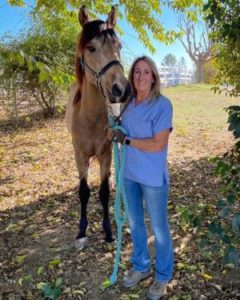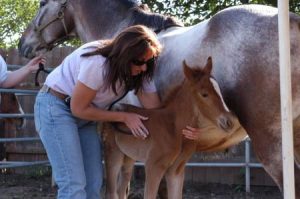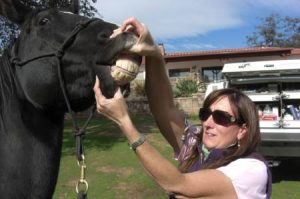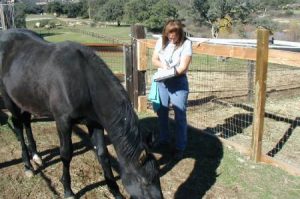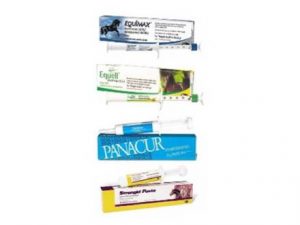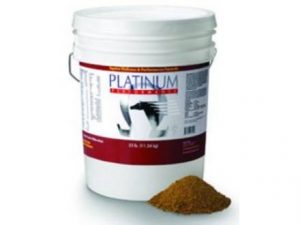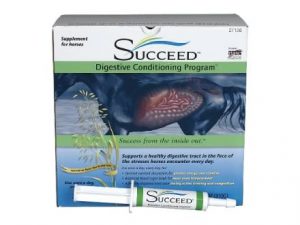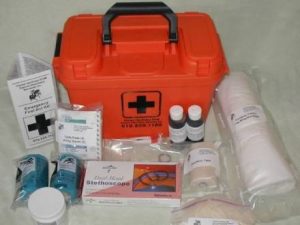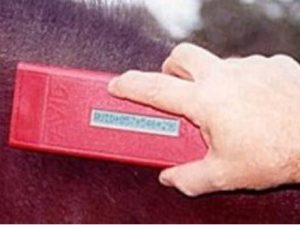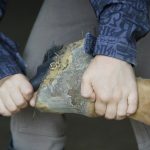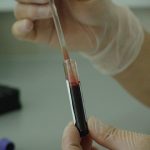In general, stallions are stronger and more aggressive. They tend to be mouthier, more inclined to bite, grab, and spar with handlers. They tend to be quicker to strike and rear up. They are more likely to fight than to flee. Usually they are kept in isolation from other horses, to control who and when they breed and to prevent battles with other male horses for dominance. They require more formidable facilities to contain them safely and securely. Stallion handlers must be confident and experienced. Unless there are compelling reasons of superior genetics and performance abilities, everyone concerned is better off with a gelding, including the stallion. With castration, there is a significant reduction in male aggressive behavior toward other horses and toward people. Libido and sexual interest are also reduced. Generally the result is a more manageable and docile individual.
Elimination of fertility is another reason to castrate. Puberty begins at 10 to 12 months of age, so yearlings can and do get mares pregnant. Castration eliminates fertility.
Another reason for castration is to reduce masculine conformational features. Testosterone affects growth leading to earlier closure of growth plates in developing bones. The result is a shorter, stockier, more muscular stature. The muscles of the face, jaws, and neck are particularly powerful in the stallion. Castrating at an earlier age will reduce these masculinizing effects of testosterone. Unfortunately studies have not been performed in the horse to pinpoint the critical ages of testosterone’s effect on conformation. Likely it is sometime before 18 months of age since so much growth occurs by this age in the horse.
Finally, another reason for castration in the horse is to remove a diseased testicle. Trauma from a kick, twisting (torsion) of a testicle, inguinal hernia, and testicular cancer are examples of diseased testicles that need to be removed for the health of the animal. Interestingly the remaining testicle will increase in size and sperm production; consequently stallions with just one testicle remain fertile.
Any procedure that results in stress will weaken the individual’s immune system, increase vulnerability to infection, and reduce the ability to cope with environmental stresses. Certainly castration represents a major shock to the system of a stallion, resulting in significant post-operative pain and inflammation. Consequently it is preferred that the stallion is in good health at the time of castration, without signs of fever, infection, parasitism, or other signs of disease. Vaccinations should be administered prior to the surgery date. Of particular concern is Tetanus vaccination, which should be boostered on an annual basis.
It is important to determine if both testicles are descended fully into the scrotum. If one or both testicles fail to descend fully into the scrotum, the stallion is termed a cryptorchid. Cryptorchid castration is considerably more involved than routine field castrations, requiring a hospital surgical setting with more equipment and personnel. Some stallions are very tolerant of scrotal examinations, but others require sedation and physical restraint. While checking for crytorchidism, the veterinarian will also check for an inguinal hernia.
Weather is another consideration. Extreme weather conditions can affect recovery from castration in a couple ways. First, extreme weather represents another stress the individual must cope with. Recovering from castration is more difficult when also battling the elements, such as during a harsh Northeaster or a wicked summer heat wave. Exercise, as pointed out later in the article, is an important aspect to recovery from castration. During extreme weather conditions, horses tend to move around less. This reduced movement can lead to further complications in healing from the surgery.
Flies are overrated as a complicating problem for castration. The surgery site is in an area difficult for flies to reach. For the brave souls that do venture up there, the horse’s tail is right there to discourage them. If anything, the flies help to keep the horses moving. If it’s a choice between cold, wet, muddy months or warm weather with lots of flies, they’ll do better with the flies.

During the first 24 hours after the surgery the biggest concern is bleeding. Large vessels have been cut during the castration. It is best for the horse to remain fairly quiet and confined afterwards, avoiding stretching the tissues cause by a lot of activity. This encourages the blood clots to develop and solidify, minimizing the hemorrhage. An occasional or slow drip immediately after the surgery is expected.
After the first day and for the next 2 to 3 weeks, the big concern is swelling. They all get varying amounts of swelling in the sheath area, which normally reaches a peak by the third or fourth day. In some it may get as large as a soft ball. Swelling in the scrotal area is another story. The incisions are supposed to stay open and drain. Healing is supposed to occur from the inside first and seal up on the outside last. This process normally takes a couple of weeks. To check for swelling in this area, one needs to bend down and look up into the inguinal area, where the scrotum was. The key to prevention of swelling here is EXERCISE. Exercise can be started on the first day after surgery. Begin with at least 15 minutes of exercise twice a day. The first couple days can begin with mild exercise. By the third day, step it up to more vigorous exercise. By the end of three weeks, you should be out of the woods. Antibiotics are generally not required unless infection becomes a complication.
Following surgery, the gelding is essentially sterile within 3 days.
If you have any questions about equine castration contact us at 619.659.1180.

